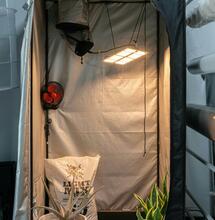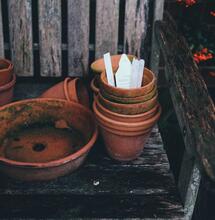Greenhouse Construction

The freestanding greenhouse offers the most flexibility in size and location. It can be built to take full advantage of the sun, but it does not retain heat well and can be expensive to keep warm. Numerous steps can be taken to minimize heating and cooling costs and environmental impact of maintenance. Many frame types and coverings are available in kits or raw materials. Coverings can also be easy to open for ventilation.
There are also a number of good websites listed at the beginning of this chapter to help you choose the plan that works best for you. For more information on types and prices, visit websites such as www.hoophouse.com. [caption id="attachment_6165" align="alignnone" width="500"] The black plastic is pulled over the PVC irrigation pipe frame of the greenhouse every afternoon to give the plants 12 hours of uninterrupted darkness to induce flowering.[/caption] Hoop houses are inexpensive, practical, and easy to build. They can be made to cover raised beds or be constructed on flat ground. They consist of a series of parallel PVC plastic or more durable steel pipes arched over two points of anchor. The arches are connected across the top with a stay to add strength to the structure. A plastic skin is secured over the arches with tape or removable clamps. Ends can be closed or kept openat night for ventilation. The outer skin can be manually removed during hot weather and replaced during cool nights. Once the plants outgrow the plastic skin it is removed. It is replaced with a 15 cm plastic mesh that supports and trellises the plants as they grow. Hoop greenhouses with removable plastic coverings work well when growing medium-to-large plants. The plastic is removed when weather warms and is replaced with 15 cm plastic mesh that acts as a trellis to keep branches from breaking under the weight of buds. Hoop houses are inexpensive as well as quick and easy to set up. Plants can be moved in before or after a hoop house is set up. Once plants outgrow them, hoop-house structures turn into trellises to help support heavy flowering plants.
Greenhouse Construction
Both large and small greenhouses cost money, time, and space. Greenhouses with a foundation are also more permanent. Regardless of the type of greenhouse you construct, it should be on flat ground and have easy access. This section of the chapter on greenhouses discusses different construction options, touching on main points to consider. However, providing construction instructions with diagrams is beyond the scope of this book. For more specific information, type “greenhouse plans” into an Internet browser. [caption id="attachment_6166" align="alignnone" width="500"] Slide a 20-foot (6.1 m) piece of schedule 40, 0.075-inch (1.9 mm) PVC irrigation pipe over 2 opposing pieces of rebar 10 feet (3 m) apart to form an arch.[/caption]
Size of Greenhouse
Total area of the greenhouse is determined by the number of plants you intend to grow and how long they will be in the ground or in pots. The longer plants grow, the more room they will need and the more problems that can occur. Induce plants to flower when they are 90 cm tall, and allow a minimum of 0.8 m2 for indica-dominant varieties and up to twice as much space for sativa-dominant varieties. Air circulation between plants can be a problem if plants become too big. Large plants that are planted early in the season often outgrow the greenhouse, which requires that the outside skin of the greenhouse be removed so growth is not impaired. Ample airspace is essential in greenhouses. At least half the space in a greenhouse should be airspace. This space is necessary for air exchange, air circulation, and ventilation. Molds, mites, and insects become problems in greenhouses with inadequate airspace. As a general rule, plants should take up about 0.33 to 0.5 percent of the space in a greenhouse and air 0.5 to 0.66 percent. This ratio allows adequate air circulation. [caption id="attachment_6167" align="alignnone" width="500"] Several arches are erected and connected with individual pieces of PVC irrigation pipe secured with duct tape. A long, steel fencepost provides added stability. The hoop house is covered with plastic in the spring. When hot summertime weather arrives, the plastic is replaced with trellis netting.[/caption]
Framing
Framing can be wood, bamboo, metal, or plastic. Framing to specific dimensions and building with premade framed panels has the advantage of quick installation and breakdown for winter storage. Build all structures using standard dimensions for framed glass, plastic panels, and sheeting to get the most from your materials and work more efficiently. For example, a 2.4 m greenhouse can be made with two 120 cm-wide fiberglass panels. Center height depends on the level of the eaves. Low-growing plants can take an eave of 1.5 m; tall plants need 3–4.3 m. Greenhouse walkway space is important for easy access. Too many gardeners are surprised when it turns into “crawling room only!” Overgrown foliage in large or small greenhouses cuts air circulation and promotes disease and pest attacks, as well as broken foliage. Room to move a wheelbarrow in a large greenhouse is especially valuable when plants grow beyond beds. [caption id="attachment_6168" align="alignnone" width="500"] Hoop houses are easy to set up. First, weed barrier cloth is set down and secured. The greenhouse is laid out in a grid in sections measuring 10 × 8 feet (3 × 2.4 m). Two-footlong (0.6 m ) steel rebar stakes are driven through the weed barrier and halfway into the ground.[/caption] The floor of the greenhouse can be covered with weed barrier cloth, gravel, bricks, or concrete. Place a thermal blanket under floor covering to insulate from cold ground. A Styrofoam base in a small greenhouse keeps cold soil from cooling containers and greenhouse. You can also make raised, flat, or sunken beds in the greenhouse floor. Dirt floors can get muddy and are difficult to keep “clean.” Cover muddy floors with sawdust or straw. A wood, brick, or concrete base around the bottom of the greenhouse adds stability to the structure. Planting in the earth floor of the greenhouse allows you to use organic methods. The plants cannot be moved easily, but they grow bigger and require less maintenance than container-grown plants. Without containers, plants also retain a lower profile, but I still like raised beds. Growing in Mother Earth is always better than planting in pots when growing big plants. Most all the principles that apply to outdoor growing apply to growing in a greenhouse, too. [caption id="attachment_6169" align="alignnone" width="500"] This prefabricated greenhouse comes with its own covering for blackout. The covering comes equipped with ventilation inlets and outlets.[/caption]
Benches
A greenhouse equipped with benches makes tending plants much easier. Water catchment systems can also be set up to recycle nutrient solution. I like a greenhouse with tables because when plants are off the floor, they stay warmer and are easier to access. Airspace below benches can serve as storage area for containers and water reservoirs. Set up tables along the length of the greenhouse to make the best use of space. Allow at least 91.4 cm between tables and greenhouse walls to accommodate plant growth and provide for comfortable access. This is an excerpt from chapter 11 “Greenhouses” from the Cannabis Encyclopedia (596 pages, 2,000+ color images, large A4 format) by Jorge Cervantes that is available everywhere in English. Spanish edition will be available January 2017. For more information please see Jorge´s website, www.marijuanagrowing.com. [caption id="attachment_6170" align="alignnone" width="500"] A crop of 1–2-foot-tall (30.5–61 cm) clones or seedlings planted on May 1 can be harvested in mid-July in a greenhouse that is darkened for 12 hours daily.[/caption] Jorge Cervantes



.png)